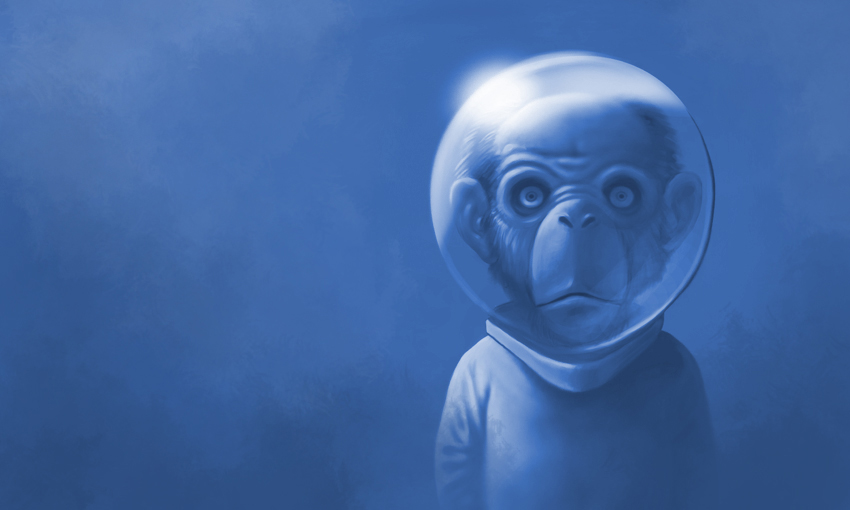
(Continued from Organic Alchemistry 2: Wave Genetics)
We humans are spectacularly unimpressive.
We may think we’re hot and our shit don’t stink, but truthfully, in the grand scheme of things, humans aren’t as unique as we think we are. There’s truly not very much that differentiates us genetically from our closest cousin primates, the chimpanzees and the bonobos. In fact, given enough evolutionary time, they will also move out of their second density existences and graduate onto our level of consciousness.
Don’t believe me? They have already started moving into their own ‘stone-age’ (I’ll get into this in a future posting). But you know what, this post is not about them. This post is about us, and how we got fast-tracked onto 3rd density before our time. External-intervention is something that is unforeseen, and part of the unexpected, human-induced sequent changes that i wrote about in one of my previous posts, which, my friends, is how it happened (more on this, in upcoming posts also).

As you can see from the diagram, humans (homo sapiens sapiens), chimpanzees (pan troglodytes), and bonobos (pan paniscus) are genetically separated only by about 1.2% from each other, with the gorillas, coming in at a distant 1.6% from the trio of homo and the two pans. [1] So what is it that makes us uniquely different from chimps and bonobos?
Looking at the diagram, it is fairly obvious that while all the other primates have 48 chromosomes, we only have 46. It seems then, as if we are two cards short of a full deck, but that’s not really the case at all. In reality, by casting away a small amount of our chromosomes and turning off other small segments, we, in effect, got a DNA upgrade, and this one wasn’t a minor one. It was a major product release!
We went from Homo 2.4 and jumped all the way to Homo 3.3* in what amounted to a tiny sliver of time on the scale of biological evolution.

The upgrade happened over 200,000 years ago, but we only found out about this latest upgrade in 2005, when we finally learned enough to figure out something that had been hidden within our bodies for all that time.
We discovered a fused chromosome that allowed us to move, as a species, onto a divergent path, away from our brethren great apes, to become part of the human race. But more importantly, the fusion event reduced our chromosome numbers without losing any information at all. In fact, it looked to have been done by a top-notch surgeon.
This surgeon took great care to delete sections of redundant information, as well as turned off other areas that needed to remain within the DNA sequences, but not necessarily expressed. It was brilliantly done, and it was as precise as any bio-engineered project done today.
In fact, I’m going to go on a limb and say that with our technology as of 2017, I don’t think we could do as fine a job. Maybe in another twenty or thirty years…maybe we can duplicate this feat, but for now, we can’t approach this delicate of a job with the butcher tools we have.
This fused chromosome is not found in any primate or mammal, living or long dead. It is only found in three variants of the human species: the Neanderthals, the Denisovans, and us. It is called Chromosome 2.
Chromosome 2

To say that there have been numerous debates about this chromosome is to put it rather mildly. People have been known to come to verbal blows over this gnarly little chromosome, and for good reason.
When one’s very identity, or the relevancy of one’s God is put on the line, arguing about an ideological point of view is the least bloody of the ways people have tried to settle their differences.
How it works is thus: Throw into the fight ring a bunch of people who have die-hard ideas about evolution and creationism and let them duke it out until there is only one man left standing. That last man still alive will be able to claim that his God (be it the God of Atheism or some other Deity) is the best God of all. And that’s how God is able to stay alive and relevant.
In any case, I need to get on with it and talk about the actual thing that matters–the chromosome itself.
Chromosome 2 is a very important chromosome in the human genome. It is the second-largest human chromosome, spanning more than 242 million base pairs and represent almost 8% of the total DNA in human cells. [2]
The chromosome is a gorgeous result of an end-to-end fusion of two ancestral chromosomes, and the handiwork cannot be considered anything but brilliant. The sections that needed to be snipped were done at the precise section in between two important nodes, and the resulting unused ends were cleanly deleted.

Then, within the remaining section that had been fused together, certain areas that were redundant were either turned off, or removed completely. In the diagram below, you can see that the single-ended telomere of the chimpanzee chromosome changed into the double-ended telomeres of the human chromosome.

The single chromosome was created by careful alignment of the various areas that needed to be aligned. Then, someone with a very sharp scalpel, snipped it with razor precision and then joined them back together at the snipped ends, resulting in a chromosome with double-ended telomeres.
Of course, you can argue that it is simply a mutation from the process of evolution, but realistically, mutations of this nature are very rare, and the probability that this mutation would occur at the same time in large numbers of individuals is so staggeringly low that I am going to assume its impossibility.
Furthermore, we have an almost fail-safe system whereby chromosomal rearrangements of this type are not easily passed to our children because we have two copies of each chromosome. When mutations this severe occur in a person, it will affect one of the chromosomes and he or she will often be unable to produce gametes.
To add another layer of protection, we have to also take into consideration that a baby has, not one, but two parents. The other parent also contributes an additional set of chromosomes which allow for self-correction of any natural mutations.

When the chromosome number in the sperm doesn’t match that of the egg, it usually does not get fertilized. If the egg actually gets fertilized, which on the rare occasion will happen, it almost always results in one of three situations.
- The zygote dies and is discharged.
- An infant is born with serious genetic diseases.
- A healthy infant is born with serious genetic mutations that causes him or her to be infertile later in life. [3]
Problems associated with chromosomal alignment lead to spontaneous miscarriages and genetic abnormalities such as Down’s Syndrome. The chance that the offspring will be both viable and fertile is slim to none.
Of course, some folks will argue that evolution was the only component in this development, and I would take that into consideration—as soon as we find a single instance of a human with 48 chromosomes. If it were true that a chromosomal split occurred in human evolution, then there would be two distinct human groups, one with 48 chromosomes, and one with 46 chromosomes. [4]

The problem is, we have never been able to find a single human, dead or alive, with 48 chromosomes, and it wasn’t for lack of trying.
We sequenced all the ancient bones we could find, and out of all the humans (there are currently three types), ancient or otherwise, every single one of them was a bonafide card-carrying 46-chromosome Homo.
Now, the three types of humans (actually there is one other that shows up in our genetic sequences but we haven’t been able to find any fossils of that particular human group yet) are the Neanderthals, the Denisovans, and us Modern humans.
Anthropology can now confidently report that Neanderthals, Denisovans (and this other yet-unnamed human) are in fact the same human species as you and me. They are genetically speaking, true humans and are fully part of the human lineage–which brings me to another question.
Why do they have cool names like Neanderthal and Denisovans, and all we get is the designation of Modern?
(To Be Continued…)
…
[1] Denisovans, humans, and the chromosome 2 fusion
[2] Chromosome 2
[3] Of Apes and Men


Are you familiar with recombinant DNA and if so what do you think of it? Do you think it’s possibly relevant in this particular case? I forget if I brought this up before.
LikeLiked by 1 person
monkey teaches human…
LikeLiked by 1 person
Allan, ha! That’s pretty cool. Yep. They have definitely reached the stone age, where they are widely using stone tools.
LikeLike
Stephen, we’re pretty basic in our research right now, on recombinant DNA. We can do some things well (like little glow fish) and other things not so well (like blue roses). We’re still at the beginning phases of genetic manipulation, that’s for sure. I know I read somewhere that we are capable of creating biological bodies for androids, but I haven’t done too much digging into that yet. Maybe I will.
LikeLike
I wonder if s/he was born in ‘Year of the Monkey’…?!?…definitely born as a lao tzu!
LikeLiked by 1 person